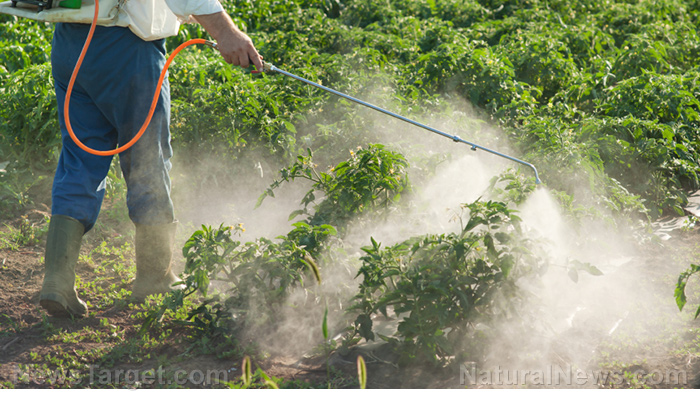Coumaphos – toxicity, side effects, diseases and environmental impacts
12/05/2017 / By Michelle Simmons

Coumaphos is an insectide that belongs to the group of organophosphate compounds. It is used to control a wide variety of insects, such as cattle grubs, screw-worms, lice, scabies, flies and ticks. Moreover, it is used to kill ectoparasites, which are insects that live on the outside of host animals, such as sheep, goats, horses, pigs and poultry. In addition, it is mixed with cattle and poultry feed to control the development of fly larvae that breed in manure. It is also used to control mange, horn flies, and face flies of cattle in dust, dip or spray formulations. This chemical is not used in agriculture or in residential areas. It works by interrupting the activity of naturally-occurring enzymes called cholinesterases, which plays a role in the functioning of the nervous system. Coumaphos can be physically described as a tan crystalline solid with a slight sulfur odor. Coumaphos can also be identified by other names, such as counafosum, coumafos, and cumafos and it has the molecular formula of C14H16ClO5PS.

List of known side effects
Coumaphos can cause several side effects in humans. It has been found to be fatal if swallowed and inhaled. It can also cause serious eye irritation and damage to body organs through prolonged or repeated exposure. According to an entry by the Centers for Disease Control and Prevention (CDC), it can cause convulsions, dizziness, sweating, labored breathing, nausea, unconsciousness, pupillary constriction, muscle cramps and excessive salivation if inhaled. Meanwhile, if ingested, it may cause abdominal cramps, diarrhea and vomiting.
Similar to all other organophosphorus chemicals, coumaphos poisoning can cause symptoms such as excessive salivation, sweating, rhinorrhea and tearing. In addition, it can cause muscle twitching, weakness, tremor, incoordination, headache, dizziness, nausea, vomiting, abdominal cramps and diarrhea. Moreover, it can cause respiratory depression, tightness in chest, wheezing, productive cough, fluid in lungs and pin-point pupils sometimes with blurred or dark vision. In severe cases, it can cause seizures, incontinence, respiratory depression, and loss of consciousness. In addition, it can cause cholinesterase inhibition. For its environmental consequences, coumaphos is extremely hazardous to the aquatic environment and birds, while it is moderately toxic to other species like bees.
Body systems affected by coumaphos
The body systems that coumaphos can negatively affect are the digestive, respiratory, integumentary, ocular, nervous and muscular systems.
Items that can contain coumaphos
Coumaphos can be present in insecticide products that are used to control pests that interfere with livestock, such as fleas, ticks, scabies, and cattle-grubs. Coumaphos is used as an active ingredient in may commercial insecticides and can be found in the trade names of Agridip, Asunthol, Meldane, Muscatox, Umbethion, Co-Ral, Asuntol, Bay 21, Baymix, Dilice, Resistox, Suntol, and Negashunt.
How to avoid coumaphos
According to the CDC, there are ways on how to avoid exposure to coumaphos, especially to those people who work with the chemical. One of these ways is to use local exhaust or wear a breathing protection in order to avoid breathing in the product. Another way is to wear protective gloves and protective clothing to avoid skin contact. Meanwhile, in order to avoid eye contact, it is important to wear a face shield or an eye protection. Lastly, it is important to avoid eating, drinking, or smoking during work to avoid ingesting the chemical.
Where to learn more
- Honeybee Colony Collapse Disorder Finally Explained: Too Many Chemicals
- Poison.news
- Chemicals.news
- Toxins.news
- Pesticides.news
Summary
Coumaphos is an organophosphate insecticide used to control cattle grubs, screw-worms, lice, scabies, flies and ticks.
Coumaphos can cause serious eye irritation and damage to body organs through prolonged or repeated exposure.
Coumaphos, if inhaled, can cause convulsions, dizziness, sweating, labored breathing, nausea, unconsciousness, pupillary constriction, muscle cramps and excessive salivation.
Coumaphos, if ingested, it may cause abdominal cramps, diarrhea and vomiting.
Coumaphos can be poisonous and cause excessive salivation, sweating, rhinorrhea, tearing, muscle twitching, weakness, tremor, incoordination, headache, dizziness, nausea, vomiting, abdominal cramps, diarrhea, respiratory depression, tightness in chest, wheezing, productive cough, fluid in lungs, and pin-point pupils sometimes with blurred or dark vision.
Coumaphos is extremely hazardous to the aquatic environment and birds, while it is moderately toxic to bees.
Coumaphos can adversely affect the digestive, respiratory, integumentary, ocular, nervous and muscular systems.
Sources include:
Tagged Under:



















